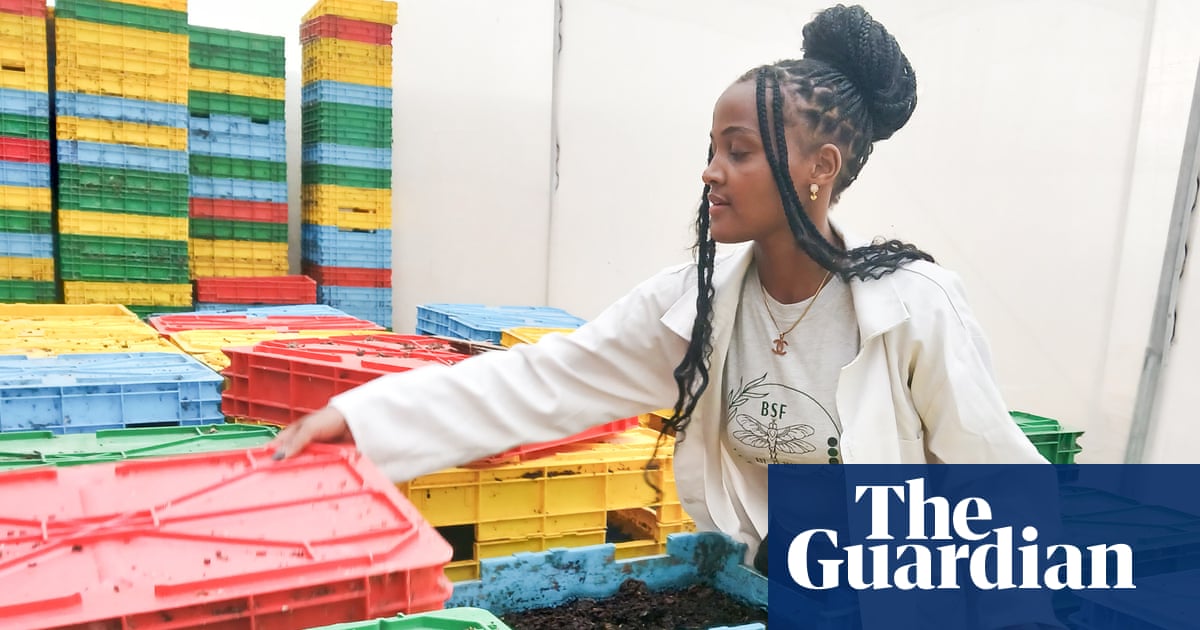In the back streets of Kenya’s capital, Nairobi, where children play football on vacant dirt blocks beside apartment blocks, a concrete building stands behind a wobbly corrugated iron fence. It seems an unlikely place for an agricultural revolution.
The half-built building is flanked by a 10m-long greenhouse and from it emerges Winnie Wambui. The 24-year-old is an engineering student, business owner and entrepreneur – and her crop is black soldier flies.
Food waste collected from local markets is fed to the fly larvae, which can eat double their body weight in a single day. It’s a low-cost waste management solution, with added benefits. Frass – matter including insect poo and exoskeletons – extruded from the larvae is sold as fertiliser and the larvae themselves become a high-protein meal for other farmed animals, including chickens and fish.
Wambui partners with the International Centre of Insect Physiology and Ecology, which is partly financed by an annual $500,000 grant from the Australian Centre for International Agricultural Research. She says this partnership has been key to her business’s success.
“Through ICIPE I have received training and BSF [black soldier fly] starter kits, and ACIAR directly facilitated travel to Germany so I could learn more about BSF farming,” she says. “My engineering background is now being directed to an agricultural business that creates economic and social impact.”
It’s also being touted as a green solution: according to the UN, food loss and food waste contribute up to 10% of global greenhouse gas emissions.
Black soldier flies – Hermetia illucens – are being promoted as a low-cost waste management solution in Australia. Though an introduced species, AgriFutures Australia says they are not considered a pest.
Luke Wheat is the founder and managing director of Arvela, a company that breeds black soldier fly larvae for the wider market. It has scaled up to sell the larvae – the industry tries to avoid calling them maggots – commercially, and Wheat is anticipating an “exciting period of accelerated growth” for the industry over the next five years.
The biosecurity risk is low, he says. “They’re not a biting insect, they are not known to spread disease and they only appear [outside farms] seasonally and in low densities.”
Wheat, who chairs the Insect Protein Association of Australia, believes the insect has a unique position in the waste management sphere as it does most of its feeding in the seven- to 10-day larval stage.
“The larvae, like a bear going into hibernation, want to pack on as much nutrient and fat stores as they can, which means waste digestion is exceptionally rapid compared to traditional composting,” he says.
The target market for the dried larvae, Wheat say, is aquaculture, but live larvae can also be fed to poultry in some Australian jurisdictions. Dried larvae, marketed as BSF protein, has been approved for use in specialty dog food, which advertises it as a “hypoallergenic novel protein”. That company said its palatability testing showed “canine satisfaction” with the insect protein was equivalent to other animal protein sources.
“The larvae can also be rendered down and the resultant oil has antimicrobials, which are good for gut-health, especially in piglets,” Wheat says.
In 2024 a $2.5m multi-industry research project, led by Australian Pork Limited, found black soldier flies “can reduce waste volumes by up to 79%” and that “the resulting fertiliser can outperform commercial synthetic fertilisers”.
In May, a five-year, $2m project by AgriFutures, in partnership with the University of Adelaide, was announced to determine industry best practice and examine regulatory challenges, including biosecurity issues surrounding transporting larvae.
In the mean time, Wheat has begun selling larvae to customers including Canberra-based Goterra, which builds mobile modular black soldier fly farms for use in council landfills, by hotel chains and by the Melbourne airport
“The units can process up to 1.7 tonnes of organic waste a day,” says Goterra’s founder, Olympia Yarger. “From each tonne of waste, the [larvae] produce 250kg of fertiliser and 80kg of processed insect protein.”
Dr Lachlan Yee harvests larvae at a farm at Southern Cross University’s Lismore campus. Photograph: Sharlene King/Southern Cross University
Researchers at Southern Cross University are also investigating whether the larvae can be used to make green fuels.
“The fat content of the BSF larvae is somewhere in the order of 20% to 30%, and through chemical engineering that could produce biodiesel,” says the research lead, Dr Lachlan Yee.
“Chitin [produced by larvae exoskeletons] is a natural biopolymer and we’re working on applications including wound-healing bandages. We’ve also started research into the use of BSF leachate to combat weeds.”
Yee has a fly farm at home which he uses to turn kitchen waste into chicken feed and fertiliser for the garden.
But through his research he has grander aspirations.
“I know we’re a long way off but the ultimate goal is to replace some of the synthetic plastics with biopolymers, and these amazing creatures can help us do that,” he says.
